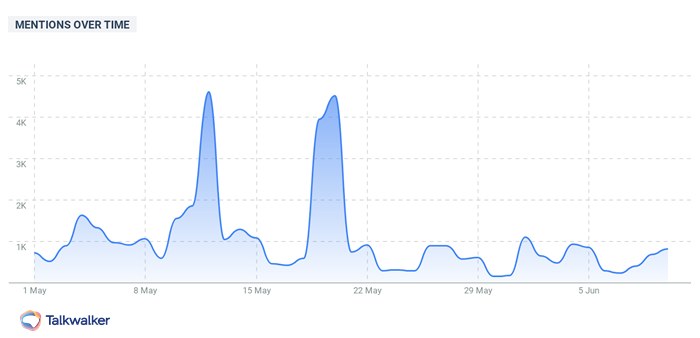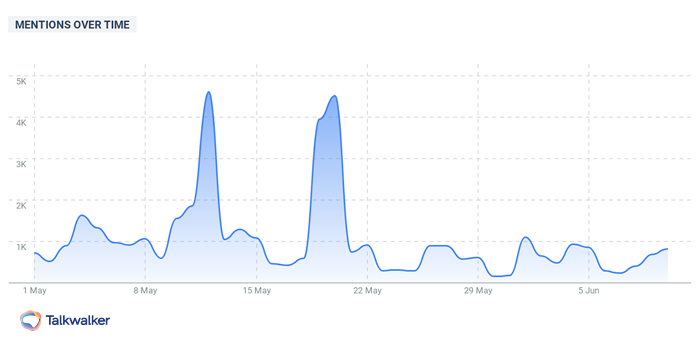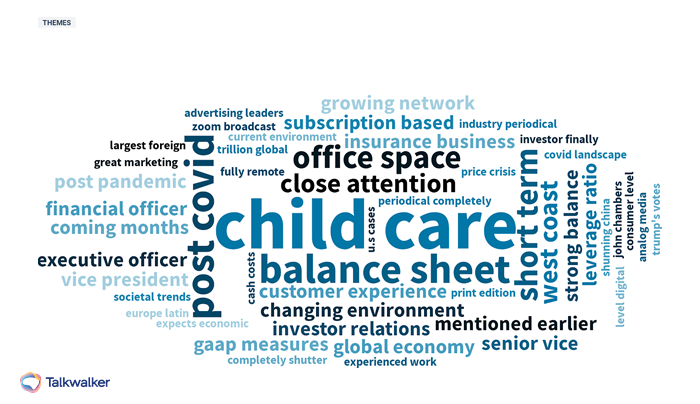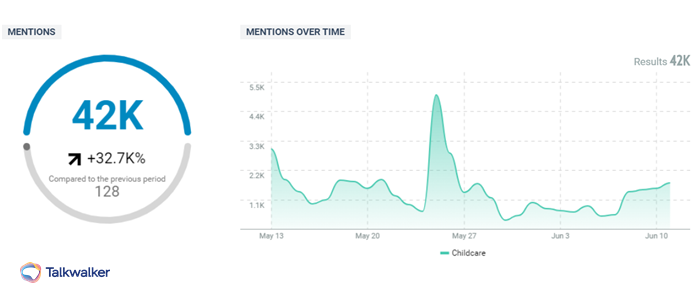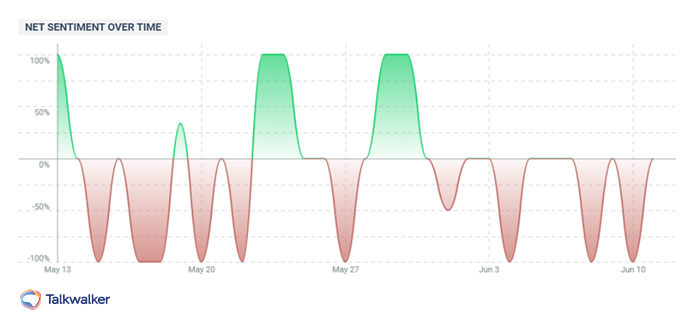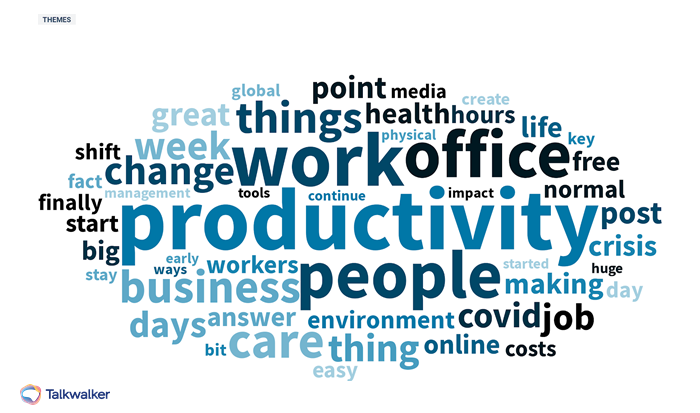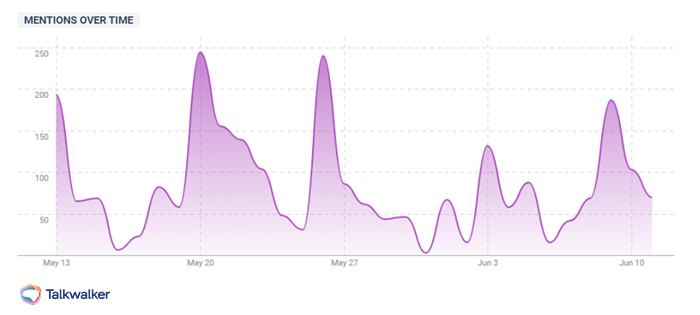DOWNLOAD: Your COVID-19 Industry Report
Nations across the world are beginning to open their borders and economies after months of COVID-19 lockdown measures, and there are many questions around what that will look like. Millions of people who have been furloughed or working from home during this time are going to be asked to return to work very soon. But these employees’ priorities probably look very different now than they did the last time they were there.
Circumstances - whether they be health or productivity related - have changed dramatically for workers around the globe because of the coronavirus this year, and it’s had an impact on their online discussion around the things they need from their employers going forward.
Conversational data around mentions for “employee guidelines” spiked each time a new region began reopening in the US last month.
By looking at the keywords that people are using in online chatter about going back to work, we can see how themes have centered around key concerns and asks that they’ll have for their management teams before being comfortable with retuning:
Terms like “child care”, and “office space” are evidence of the top issues for workers post-quarantine.
Amenities that employers may have previously offered as perks, like child care allowances or staggered weekly schedules, could become requirements across industries rather than “nice to haves” going forward. Companies will need to enact new safety protocols, reevaluate remote work policies, and perhaps even upend their entire office structure. This is imperative not just to meet their existing workers’ needs, but to attract new employees as the economy restarts.
My company has decided that we’ll have our own “go back to the office” plan AFTER the various governments involved approve it for the general populace. Which means both California and UK, THEN we’ll start implementing a slow return to the office.
I am terribly lucky right now.
— Ken Jennings stan acct (@TotchosInABox) April 20, 2020
Companies that are making transparent decisions around when their employees should return to work are earning more favorable social media mentions.
In examining the most-discussed themes in conversation around going back to work, I saw that major concerns around childcare, office spaces, and staggering employee schedules drove a lot of the conversation. These are clearly big ticket items for companies to address and have a plan of action around before they can expect to have their workers be comfortable enough to return to work sites.
Childcare
Uncertainty about what school will look like in the future, coupled with folks juggling kids while working from home this year, has made many people vocal online about the need for better childcare options for working parents. Talkwalker data shows that “childcare” was mentioned in 1,400% more headlines around employee work issues as businesses have reopened within the last month. The term is also occurring in online mentions around going back to work a whopping 32,700% more than a month ago:
Mentions for “childcare” in posts and comments about going back to work have increased as parents assess their kids’ needs going forward.
It’s clear that making the decision to go back to work will, for many employees, be reliant on whether or not their little ones are secure, too. Until there’s a more concrete plan around schools reopening in the Fall, people aren’t confident about how feasible going back to a regular work schedule will be for them.
In about a week, if the government hasn't given us a credible #coronavirus back-to-work plan, we need to make our own schedule with our own criteria. My patience for obeying a government that refuses to inform us of the basics (healthcare supply and demand) is nearing an end.
— Scott Adams (@ScottAdamsSays) April 6, 2020
With uncertainty around federal guidelines for reopening in many areas, workers will look to employers to make the right decisions for their employees.
Companies who want to successfully support (and retain) their workers should consider supplying childcare options, whether that looks like providing in-office services or allocating some of their overall brand budget for parents to pay for caretaking while they are working. This will certainly alleviate some of the stress that a lot of employees are currently feeling in the face of uncertainty around their work-life balance.
Get your COVID-19 Industry Report now
Office spaces
Social distancing will still be necessary as the world continues its search for a COVID-19 vaccine. Many workplaces - particularly traditional corporate office spaces - do not currently allow for that kind of separation between employees.
like a week or so before covid really hit, my company started rolling out an open office layout that would make social distancing impossible. now, we might never go back to the office. ♂️
— Gym Silverman (@jimesilverman) May 20, 2020
Companies will need to evaluate their workplace structure, and perhaps make changes based on recent health and safety protocols.
The hype around widely adopted open office plans was already on the decline pre-coronavirus, when their promise of productivity and collaboration fell decidedly short. Now, the idea of having people sit in common spaces without spatial barriers seems akin to putting employees in a petri dish from 9 to 5. In fact, this office layout has been linked to increased COVID-19 outbreaks in some areas.
What kind of adjustments will now need to be made to open office plan structures, to ensure that people can keep a safe distance from others when they go back to work?
Sentiment around “open office plans” has been incredibly negative over the past month as back-to-work plans have been discussed, with spikes in positive mentions tied to posts about companies who are doing away with them.
Employers are looking for alternative options to keep their open offices while still ensuring workers’ health and safety. Companies could adjust seating charts so that employees have a desk or two between each other, or we may see cubicles making a comeback. For workplaces with tight spaces, “one-way corridors” that minimize personal contact and max-occupancy rules for meeting rooms might be how folks accommodate for social distancing measures.
Whatever the course of action taken, many employers will be reassessing their workplaces and what they’ll ask of their employees during the adjustment period. In some cases, that could even look like embracing remote work for the foreseeable future.
Twitter announcing the option of remote work forever is definitely a bellwether for silicon valley workplace strategies. This will be a space to watch in the coming months.
— Aaron Levie (@levie) May 12, 2020
Some companies aren’t going back to their pre-COVID work environments, and giving workers the option to remain remote may inspire others to do the same.
Staggered schedules
Productivity has been a big theme in general conversation around working from home during quarantine, but looking at more recent trends shows just how closely the topic ties in with where people are working right now:
Keywords like “office”, “work” and “finally” are trending with “productivity”. “Home”, however, is not.
While working from home forever may be the dream for some people, others have been struggling to keep up their regular productivity. Concerns about coronavirus spread aside, there are many people who are looking forward to being back in the daily grind:
Never thought I’d say this but I am so relieved to finally have a back to work plan. Can’t wait to return I’ve missed it so much❤️
— L ✨ (@OliviaSpencer12) May 21, 2020
Some folks have embraced remote work, but others are missing the structure of pre-COVID days.
With workers craving the stability of their commutes and desk chairs, employers will need to take measures to ensure that they can come back to the office in a way that’s safe for everyone. Supplying things like masks and disinfectant will be the bare minimum - companies will also need to enact policies that limit the number of people who are even in an office at once to comply with social distancing concerns.
Some corporations may be taking their cues from how education systems handle bringing students and faculty back to class. In California, one of the first US states to both enact and reopen from coronavirus stay-at-home orders, the Department of Education will be introducing new instructional models with staggered start times and schedules for students when school’s back in session. Discussions around using those tactics in the corporate world could result in a new kind of work week - one in which employees will have more flexibility around their schedules - as well as limit the risk of COVID-19 exposure that returning to work en masse presents.
As reopening businesses has become a reality over the last few weeks, mentions of “staggered schedules” have seen an uptick online.
Some big names are already planning to put these kinds of changes into action when they open doors to workers again. Tech giant Intel has dealt with social distancing issues in their labs and on manufacturing floors during lockdown, but did maintain production of essential machinery for hospitals and healthcare providers.
This virus-killing robot prototype from @akara_robotics uses our AI tech to autonomously navigate around people while helping disinfect hospitals with UV-C light.
— Intel (@intel) May 22, 2020
Intel kept some of its workplaces open throughout the COVID-19 crisis to continue projects that supplied hospitals with technologies to help fight the pandemic.
Keeping employees safe as further reopenings are rolled out for those who have been working from home is now a top priority for Intel. In addition to staggering employees’ return to offices in phases, the company will offer regular COVID-19 screenings, limit seating in open spaces like onsite cafes, and supply disposable covers for shared keyboards. Intel is also implementing new company policies based on learnings from workers who were unable to do their jobs remotely for the last few months - workplace cleaning will be scheduled during the day when the efforts are more visible, rather than at night or during off-hours. They now know, from employee feedback, that it’s made their workers feel more comfortable.
The takeaways from themes in online conversations around returning to work in a post-lockdown world are clear: while many may be eager to restart the economy, employees will approach going back to “normal” very cautiously. By addressing their concerns with new policies and guidelines, companies can become trusted partners with their employees in this unprecedented time. They will not only build their workers’ trust in their management, but will have the opportunity to set the standard for others in their industry who need to retool their own employee models.

